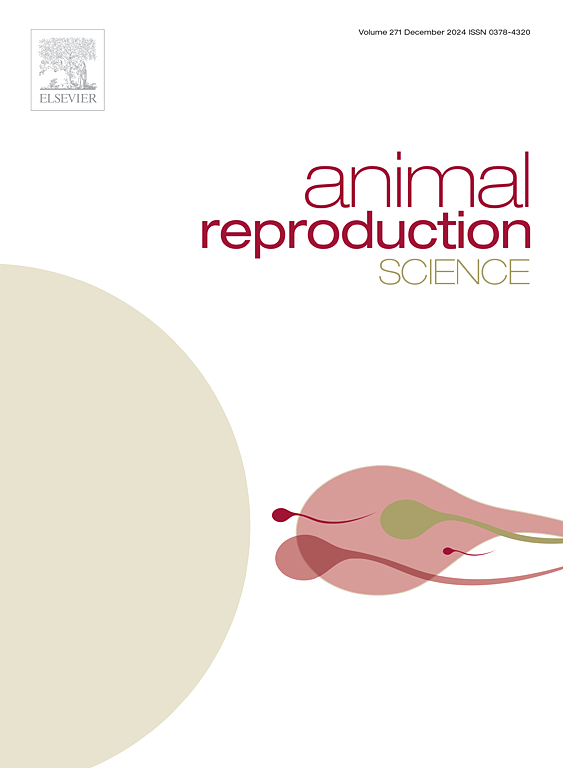同时添加花青素3-葡萄糖苷和花青素3-芦丁苷对17℃冷藏168 小时的公猪精液的影响
IF 2.2
2区 农林科学
Q1 AGRICULTURE, DAIRY & ANIMAL SCIENCE
引用次数: 0
摘要
人工授精在猪的生殖管理中被广泛应用,它可以使一只高遗传价值的公猪与更多数量的母猪受精。然而,精子在冷却介质中的稀释并不能阻止氧化过程,从而降低精子细胞的受精能力。本研究研究了açaí提取物中含有的抗氧化剂化合物花青素3-葡萄糖苷和花青素3-芦丁苷对猪精子在17℃冷却168 小时后精子活力和血浆和顶体膜完整性的影响,以及这些化合物对防止超氧阴离子形成的影响。用不同浓度的这些化合物稀释精液样本,并与长期扩展剂(维他森®)和阴性对照进行比较。在三个时间点评估结果:初始(时间0)、96 小时后和168 小时后。Vitasem®维持了高水平的活力和精子质膜完整性,而花青素与阴性对照相比没有显著改善。统计分析表明,在测试浓度下添加花青素3-葡萄糖苷和花青素3-芦丁苷对精子特征没有显著改善。这些发现表明,有必要探索其他浓度和组合的抗氧化剂,以优化精子在冷藏期间的保存。本文章由计算机程序翻译,如有差异,请以英文原文为准。
Effect of the simultaneous addition of cyanidin 3-glucoside and cyanidin 3-rutinoside in boar semen preserved under refrigeration at 17°C for 168 hours
Artificial insemination is widely used in swine reproductive management, allowing a single high-genetic-value male to fertilize a larger number of females. However, the dilution of spermatozoa in cooling media does not prevent oxidative processes that reduce the fertilizing capacity of sperm cells. This study investigated the effects of the antioxidant compounds cyanidin 3-glucoside and cyanidin 3-rutinoside, present in açaí extract, on sperm motility and the integrity of the plasma and acrosomal membranes of boar spermatozoa cooled to 17 ºC for up to 168 hours and the impact of these compounds on preventing the formation of superoxide anions. Semen samples were diluted with different concentrations of these compounds and compared with a long-term extender (Vitasem®) and a negative control. The results were evaluated at three time points: initial (time 0), after 96 hours, and after 168 hours of cooling. Vitasem® maintained high levels of motility and sperm plasma membrane integrity, while the cyanidins did not provide significant improvements compared to the negative control. Statistical analysis indicated that the addition of cyanidin 3-glucoside and cyanidin 3-rutinoside at the tested concentrations did not result in significant improvements in sperm characteristics. These findings suggest the need to explore other concentrations and combinations of antioxidants to optimize sperm preservation during cold storage.
求助全文
通过发布文献求助,成功后即可免费获取论文全文。
去求助
来源期刊

Animal Reproduction Science
农林科学-奶制品与动物科学
CiteScore
4.50
自引率
9.10%
发文量
136
审稿时长
54 days
期刊介绍:
Animal Reproduction Science publishes results from studies relating to reproduction and fertility in animals. This includes both fundamental research and applied studies, including management practices that increase our understanding of the biology and manipulation of reproduction. Manuscripts should go into depth in the mechanisms involved in the research reported, rather than a give a mere description of findings. The focus is on animals that are useful to humans including food- and fibre-producing; companion/recreational; captive; and endangered species including zoo animals, but excluding laboratory animals unless the results of the study provide new information that impacts the basic understanding of the biology or manipulation of reproduction.
The journal''s scope includes the study of reproductive physiology and endocrinology, reproductive cycles, natural and artificial control of reproduction, preservation and use of gametes and embryos, pregnancy and parturition, infertility and sterility, diagnostic and therapeutic techniques.
The Editorial Board of Animal Reproduction Science has decided not to publish papers in which there is an exclusive examination of the in vitro development of oocytes and embryos; however, there will be consideration of papers that include in vitro studies where the source of the oocytes and/or development of the embryos beyond the blastocyst stage is part of the experimental design.
 求助内容:
求助内容: 应助结果提醒方式:
应助结果提醒方式:


